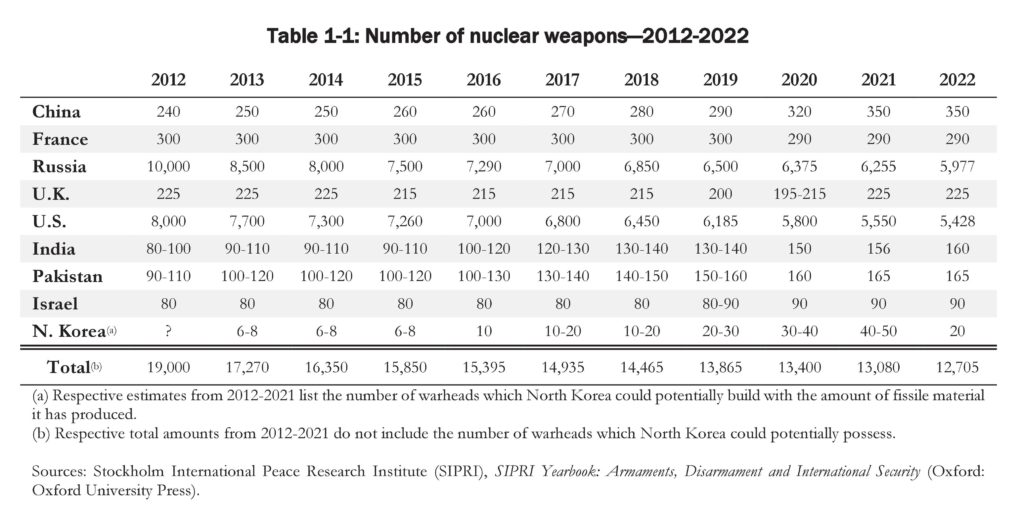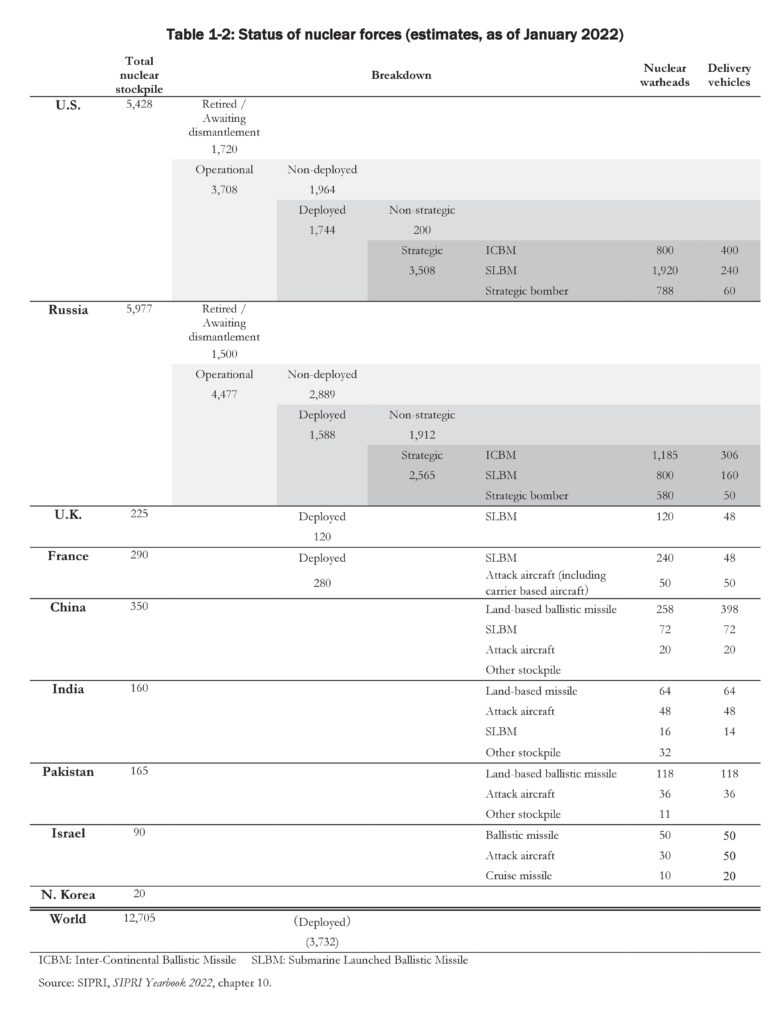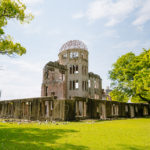Hiroshima Report 2023Chapter 1 Nuclear Disarmament Disarmament1 (1) Status of Nuclear Forces (estimates)
Chapter 1 Nuclear Disarmament Disarmament1
As of December 2022 , eight countries have declared that they possess nuclear weapons. According to Article IX-3 of the Nuclear Non-Proliferation Treaty (NPT), “a nuclear-weapon State is one which has manufactured and exploded a nuclear weapon or other nuclear explosive device prior to 1 January 1967.” China, France, Russia, the United Kingdom, and the United States meet this requirement, and have acceded to the NPT as nuclear-weapon states (NWS) as de fined by the treaty. The three other countries that have tested nuclear weapons and declared having them are India, Pakistan and North Korea. India and Pakistan have never been parties to the NPT. Israel, a non-NPT state, has maintained a policy of “nuclear ambiguity” by neither confirming nor denying having nuclear weapons, although it is widely believed to possess them. 2 (No conclusive ev idence has emerged that Israel has con ducted a nuclear explosive test.) In 2003, North Korea declared its withdrawal from the NPT, and, subsequently, its acquisition of nuclear weapons. In this report, these four additional states that have publicly declared possession of, or are believed to possess nuclear weapons are referred to as “other nuclear-armed states.”
The total number of nuclear weapons in the world , which grew to approximately 70,000 at the peak of the Cold War era, has been reduced significantly since the late 1980s. According to the estimates by the Stockholm International Peace Research Institute (SIPRI), however, 12,705 nuclear weapons still exist on the Earth, with the U.S. and Russian nuclear stock piles together constituting approximately 90 percent of the total.
This amount in cludes warheads awaiting dismantlement; if t hese are excluded, the number of nuclear warheads in the world has decreased from 9, 620 in the previous year to 9, 440 . In addition, the number of nuclear warheads deployed with operational forces has decreased from 3,825 in the previous year to 3,732 . On the other hand, the SIPRI mentioned that global reductions of operational warheads have stalled, and their numbers may be rising again. 3 Furthermore, all of the nuclear-armed states have been actively pursuing the modernization of their nuclear forces. Among nuclear-armed states, France and the United Kingdom have disclose d the maximum number of their nuclear stockpiles. In 2015, France declared it possesses not more than 300 nuclear weapons, and reported that “[i]t has no undeployed weap ons. All of it its weapons are deployed and operational.” 4 Meanwhile , the United Kingdom announced in the Inte grated Review of Security, Defence, Development and Foreign Policy published in March 2021 that it would increase the overall nuclear warheads stockpile ceiling from no more than 180 to no more than 260.5
It is widely estimated that China, India and Pakistan have each added about 10 warheads annually over the past several years. North Korea has also been bolstering its nuclear capability both qualitatively and quantitatively.
The United States disclosed the number of nuclear war heads for each year through 2020 in Oc tober 2021 . According to th the disclosure , the number of nuclear warheads (including those deployed and in storage, but not including those retired or awaiting dis mantlement) as of the end of 2020 was 3,750 —a decrease of 55 warheads from the previous year. In addition, approximately 2,000 U.S. warheads are retired and awaiting dismantlement. In 2000, the United States dismantled 184 warheads.6
1 This chapter is authored by Hirofumi Tosaki.
2 Israel’s Prime Minister Yair Lapid stated on August 1, “The operational arena in the invisible dome above us is built on defensive capabilities and offensive capabilities, and what the foreign media tends to call ‘other capabilities.’ These other capabilities keep us alive and will keep us alive so long as we and our children are here.” It is considered that the “other capabilities” imply nuclear weapons. Andrew Carey and Amir Tal, “Israel’s Prime Minister Makes Rare Allusion to Country’s Nuclear Weapons Arsenal,” CNN, August 2, 2022, https://edition.cnn.com/2022/08/02/middleeast/israel-lapid-nuclear-remarks-intl/index. html.
3 Stockholm International Peace Research Institute, SIPRI Yearbook 2022: Armaments, Disarmament and International Security (Oxford: Oxford University Press, 2022), chapter 10.
4 NPT/CONF.2015/10, March 12, 2015.
5 United Kingdom, Global Britain in a Competitive Age: The Integrated Review of Security, Defence, Development and Foreign Policy, March 2021, p. 76.
6 National Nuclear Security Administration (NNSA), “Transparency in the U.S. Nuclear Weapons Stockpile,” October 6, 2021, https://www.energy.gov/sites/default/files/2021-10/20211006%20-%20 U.S.%20Nuclear%20Stockpile%20Fact%20Sheet.pdf.








